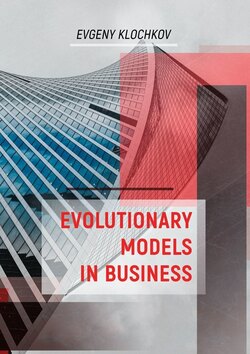Evolutionary Models in Business

Реклама. ООО «ЛитРес», ИНН: 7719571260.
Оглавление
Evgeny Klochkov. Evolutionary Models in Business
Prologue
Introduction
Chapter 1. Theoretical Models
1.1. Types of Cooperation Models
1.2. Evolutionary Theory and Genetic Algorithms
1.3. Evolutionary Processes in the World of Business
1.4. Formation of Ecosystems
1.5. Corporate Lifecycles
Chapter 2. Assembling the Final Model
2.1. Approach to Building Organizational Structures
2.2. Final Model
2.3. Model Application
Conclusion
Bibliographic List
Отрывок из книги
Special thanks to Oleg Evgenievich Klepikov and Aleksandr Lukich Gaponenko.
Our first meeting with Mr. Gaponenko took place in the lobby of Crowne Plaza hotel in Moscow World Trade Centre in 2017. I was considering enrolling in the Doctor of Business Administration course in IBBA at the Russian Presidential Academy of National Economy and Public Administration, at the moment. Surprisingly, the meeting turned out easy to arrange and proceeded very naturally, despite the fact that I had set very difficult tasks, i.e. to understand and structure the mechanisms of ideology creation and functioning. I was concerned with the realisation that there were really few experts of that profile or at least someone who would have a deep understanding of the area. A couple of days after the meeting, Aleksandr Lukich called and said that he knew a specialist who could help me understand the issue. A few weeks later, I found myself in the office of PSYCHEA, sitting in a meeting room with a glass wall that turned opaque at the press of a button, providing complete privacy. Although I can’t say that it was the only amazing event on that day. Acquaintance with Oleg and the first 1.5 hours of the conversation flew by like one minute. It was a sprint. He fended off all of my ideas and suggestions, explaining it to me that they were far from what I really needed. I got caught up in thought in the evening. For the next 1.5 years, we had regular meetings to discuss my future thesis paper, but even formulating the topic appeared to be a difficult task. Time went by. After each meeting, I took my time to think and came back whenever new ideas or questions would occur to me. Oleg told me not to worry, because as soon as we found the right topic that was really important for me, it would very quickly “pave its way” on paper. Amazingly, he turned out to be right. Suddenly there it was! And on the day that followed another meeting, I just got into the car and made it to the sea to write my paper. It was early spring and the awakening nature was a true inspiration. The entire year that followed passed in formulating the vision that I describe in this book. Well, let’s start!
.....
Charles Darwin was the first to formulate the theory of evolution by natural selection in his work On the Origin of Species by Means of Natural Selection, or the Preservation of Favoured Races in the Struggle for Life. He proved that variability and heredity are common properties of all organisms. Due to intensive reproduction, organisms create a sufficient amount of raw material for the selection of the “best” by destroying (eliminating) the “worst”. Moreover, natural selection functions in the presence of two factors – the intensity of reproduction and the struggle for existence. The struggle for existence inevitably follows from the high speed with which organisms increase their numbers. Further, Ch. Darwin suggests that since more individuals are produced than can survive, there must inevitably be a struggle for existence, either between individuals of the same species, or between individuals of different species, or with physical living conditions. Let us consider each type of struggle separately.
Interspecies struggle means a competition for survival between individuals of different species. It has a complex nature and manifests itself in the following types of harmful and beneficial relationships:
.....